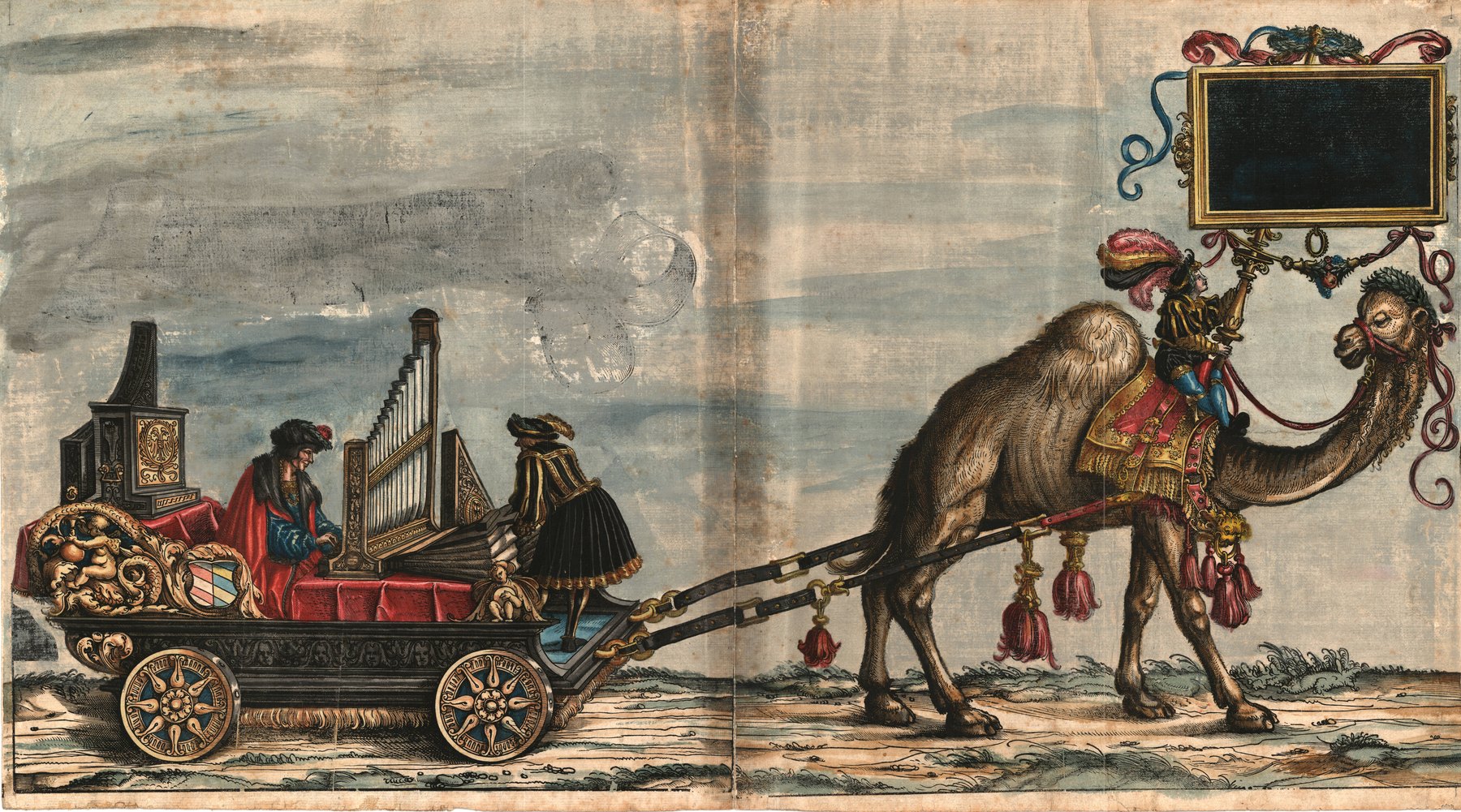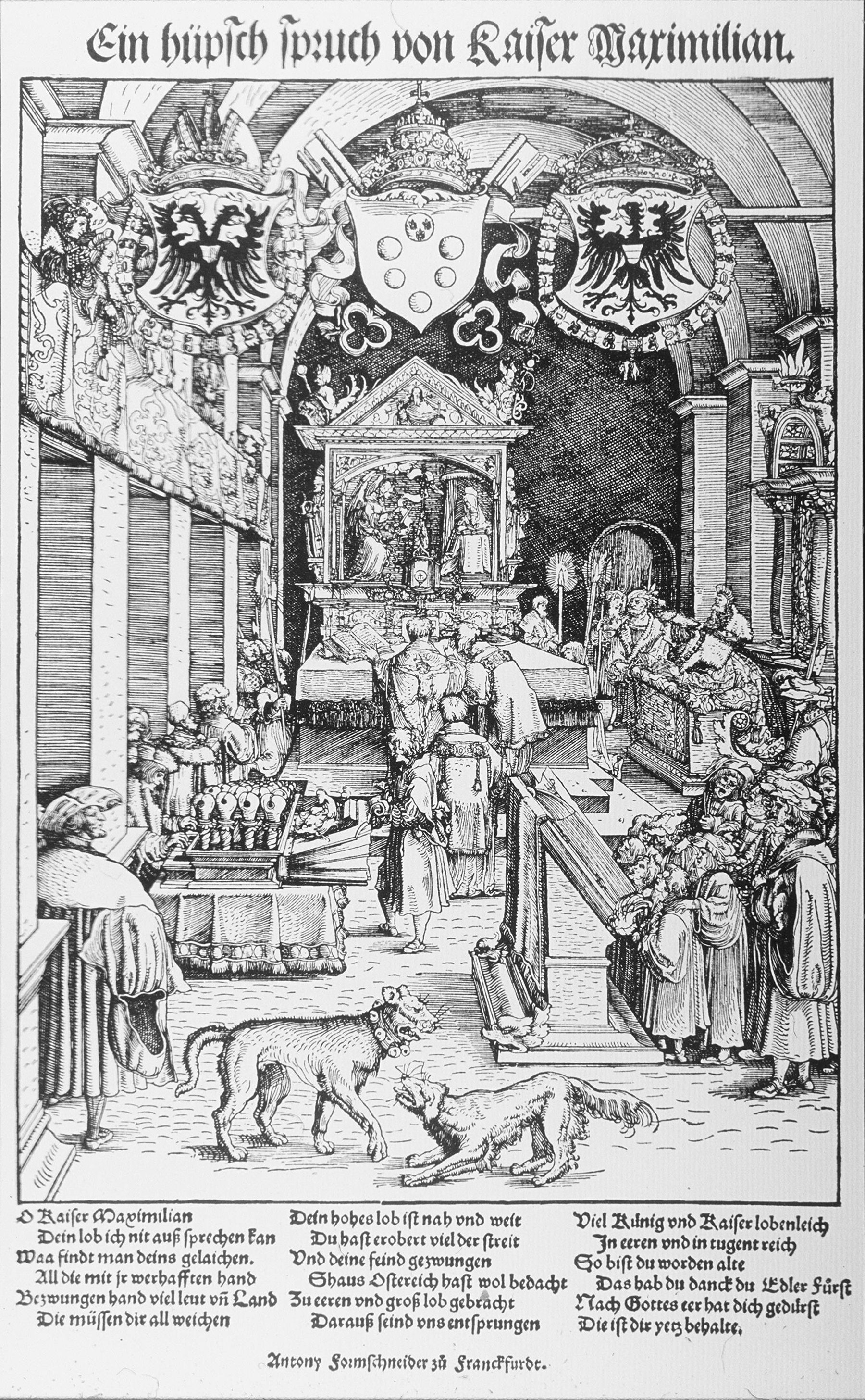“Musica Rigal vnd possetif”: Keyboard Instruments
The third musician carriage in the Triumphzug, titled “Music: Regal and Positive Organ” (“Musica Rigal vnd possetif”) (» Abb. Triumphzug Regal) features only one musician: Paul Hofhaimer (1459–1537; » C. Orgeln und Orgelmusik; » I. Hofhaimer). The image also includes a realistic detail, a bellows operator, who operates the bellows of the positive organ, without whom any organ would remain silent until the invention of the electrically driven air supply. Behind Hofhaimer, more keyboard instruments can be seen hidden in transport cases (according to the text, one is supposed to be a regal, the other could be a clavicytherium—a keyboard instrument with upright strings and a plucking mechanism like a harpsichord). Hofhaimer had been associated with the Habsburgs as an organist since his youth, serving Maximilian from 1490 and often traveling with him; his lament about having to wander “like a gypsy” is famous (see » I. SL Life as an Emperor’s musician).[26] For this reason, portable keyboard instruments were necessary, but Hofhaimer also played on large church organs (» Orgel). IOn Maximilian’s behalf, he also supervised the construction of large organ works, such as in Innsbruck and Salzburg.[27] All these keyboard instruments had not only a practical musical function but also contributed to Maximilian’s reputation, as did the musicians who played them in his name. This is exemplified in the report of the envoys from Worms at the Imperial Diet in Cologne in 1505, describing Maximilian’s church attendance “with singers, trombonists, pipers, and organs, and also with a new musical instrument that was entirely unfamiliar to us and for which we had no name.”[28] This is followed by a description of a regal with a greatly shortened resonator and reed pipes hidden inside the instrument’s body, making it seem to play without pipes. The sensation caused by such “new instruments” and the instrumental artists who played them is exemplified in the report on the festivities of the so-called Double Wedding in Vienna in 1515 (» D. Royal Entry):
“Hat der bischof von Wienn vnd kay. Ma. Capelln mit allerlay seitenspiln das hochambt gesungen / darunter vil newe vnd kunstliche saitenspil die man vor iar nit gehabt als das man Regal nennet vnd das ain Munch an alle pfeiffen erfunden / vnd aines das vogelgesang representiert / welche dan maister Paul organist der künstlichest in allen landen geschlagen hat.”[29]
(The Bishop of Vienna and the imperial chapel sang the High Mass with all kinds of string instruments, including many new and artful instruments that had not been used before, such as the so-called regal without any organ pipes, invented by a monk, and another that imitated birdsong, which Master Paul, the most skilful organist in all lands, played.)
A similar understanding can be applied to the famous woodcut by Hans Weiditz, which shows Emperor Maximilian attending Mass (» Abb. Kaiser Maximilians Kapelle). HHere, opposite the imperial singers, Hofhaimer sits at a striking organ instrument, the so-called “Apfelregal.” The curious name comes from the appearance of the pipes, “which stand like an apple on a stem,” that is, above the short reed pipes (the “stem”) stands a round resonator (the “apple”).[30] The otherwise quite loud regals thus sound softer and quieter, and look striking.
[26] See the letter from Paul Hofhaimer to Joachim Vadian on May 14, 1524; Moser 1966, 56.
[29] Nowak 1932, 84.
[30] Praetorius 1619, 148.
[1] Zum Triumphzug, seinen unterschiedlichen Versionen und der komplexen Entstehungsgeschichte informiert Appuhn 1979 und Michel/Sternath 2012; zur Bedeutung für Maximilian Müller 1982; zum Verhältnis zwischen Abbildung und Realität Polk 1992; das Zitat stammt aus der frühesten erhaltenen Formulierung des ikonographischen Programms des Triumphzugs 1512 in » A-Wn Cod. 2835, fol. 3v.
[2] Koczirz 1930/31, 531 f.
[4] Nedden 1932/33, 27 (Zitat aus den Augsburger Baumeisterbüchern von 1491, den Kassenbüchern des Rats über Ein- und Ausgaben).
[5] Vgl. Simonsfeld 1895, 267 f.
[6] Vgl. Strohm 2009, 98.
[7] Zitiert nach Waldner 1897/98, 2.
[8] Treitzsaurwein 1775, 78.
[9] Vgl. Schwindt 2012.
[10] Sie erhält im Juni 1520 bei der Auflösung der Hofkapelle nach dem Tode von Maximilian die hohe Summe von 50 Gulden „zu Irer vnderhaltung vnd Zerung“; Koczirz 1930/31, 535.
[11] Wie beispielsweise „Hannsen pfeiffer vnnd matheusen Trumelschlacher“, die 1491 ausdrücklich für ihre Dienste „bei Tanz“ an der Fasnacht bezahlt werden; Waldner, 1897/98, 52.
[12] Appuhn 1979, 172 f.
[13] Für eine Zusammenstellung der musikrelevanten Abbildungen siehe Henning 1987, 69–94
[15] Vgl. Gombosi 1932/33; Heinzer 1999, 92 ff.
[17] Vgl. Kirnbauer 2005.
[18] Vgl. Kirnbauer 2003, 243–248 (dort auch zum Folgenden).
[20] Laut Zahlungen in den Augsburger (D-As) Baumeisterbüchern Nr. 103 (1509), fol. 24v, und Nr. 104 (1510), fol. 28; freundliche Mitteilung von Keith Polk.
[21] Vgl. Jahn 1925, 10 ff., und Kirnbauer 2000, 25 ff.
[22] Kirnbauer 1992, 131.
[23] Nedden 1932/33, 31.
[24] Vgl. Polk 1989a; Polk 1989b.
[25] Hintermaier 1993, 38.
[26] Vgl. Brief von Paul Hofhaimer an Joachim Vadian am 14. Mai 1524; Moser 1966, 56.
[29] Nowak 1932, 84.
[30] Praetorius 1619, 148.
[31] So der Wortlaut in der Formulierung des ikonographischen Programms in » A-Wn Ms. 2835, fol. 8v.
[32] Vgl. Welker 1992, 189–194.
[33] Aich 1515, Titelblatt des Tenor-Stimmbuchs; zur Datierung siehe Schwindt 2008, 117 ff.
[34] Vgl. Bernoulli/Moser 1930, v–vii; McDonald/Raninen 2018.
[35] Vgl. Brinzing 1998, 137–154; Filocamo 2009.
[37] » A-Wn, Mus. Hs. 41950; Faksimile und Beschreibung in Kirnbauer 2003. Lautentabulaturen der nächsten Generation aus dem süddeutschen Sprachraum beschreibt » H. Lautenisten und Lautenspiel (Kateryna Schöning).
[38] Gerle 1533, fol. IIv.
[39] Vgl. Moser 1966, 26 und 182, Fußnote 35.
[40] Vgl. Moser 1966, 137–140; Radulescu 1978, 66 f.; siehe auch » C. Orgeln und Orgelmusik.
Empfohlene Zitierweise:
Martin Kirnbauer: „Instrumentalkünstler am Hof Maximilians I.“, in: Musikleben des Spätmittelalters in der Region Österreich <https://musical-life.net/essays/instrumentalkunstler-am-hof-maximilians-i> (2016).

